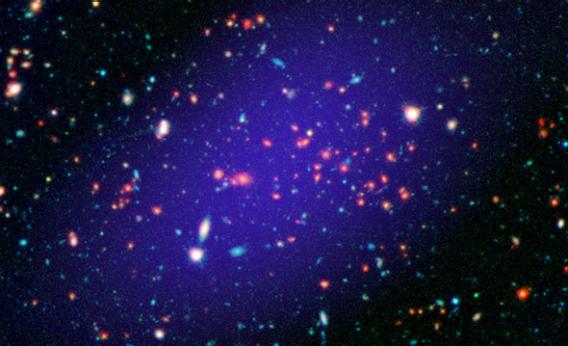Create a free profile to get unlimited access to exclusive videos, sweepstakes, and more!
The Cluster at the Edge of the Universe

I love it when a piece of news comes out that ties in so neatly with a recent episode of Crash Course Astronomy: Hard on the heels of my talking about clusters of galaxies in the distant Universe, astronomers have announced they’ve found an immense cluster 8.5 billion light-years away. It’s the most massive cluster found at this distance.
How massive? A quadrillion times the mass of the Sun massive. That’s equivalent to 10,000 galaxies like our Milky Way. That’s a huge honkin’ cluster.
The cluster is called MOO J1142+1527 (for “massive overdense object” plus its coordinates on the sky), and it was found as part of a project set out specifically to look for big galaxy clusters that are very far away. The project is called—are you ready for this?—Massive and Distant Clusters of WISE Survey.
Or, as I’m sure the astronomers involved prefer it to be called, MaDCoWS.
MOO J1142 was found in a search using NASA’s WISE (Wide-field Infrared Survey Explorer) observatory, which surveyed the entire sky in different wavelengths (colors) of infrared. Distant galaxies give off a certain ratio of infrared light, so the astronomers used software to look for objects with those color ratios. If it found any, it then checked to see if there were lots of such sources all near each other, which would indicate it could be a galaxy cluster. They found thousands of such groups, and MOO J1142 was one of the best.
Switching to Spitzer Space Telescope, they then got infrared images with higher resolution, so that individual galaxies could be better seen. Once they had that in hand, it was off to the Gemini North and Keck observatories to take spectra, which gave them the redshifts of the galaxies. The redshifts are an indicator of distance, and that’s how they determined these galaxies were so far away.
Finally, they used an array of telescopes called CARMA that looks at microwaves from space. Using a sophisticated technique (the Sunyaev-Zel’dovich effect, for those who are curious), they were able to map the gas of the cluster and determine its immense mass.
Sometimes, when we look at very distant objects, we find some that are a bit puzzling. Remember, when we look very far away, we’re seeing the Universe when it was younger. Sometimes we find galaxies billions of light-years away that are bigger than we’d expect given their young age—that means galaxies form and grow faster than we first thought.
I was completely expecting this to be the case for MOO J11452, too, because it’s so flippin’ big and so far away. But in fact, the MaDCoWS astronomers note in their journal paper that it’s within the reasonable limits of size and mass for its age (given how we think the Universe behaved when it was young). That was a fun surprise for me! I guess sometimes, not being surprised is a surprise.
They do also note that it is very large, and likely to be one of the most massive such structures at that distance or farther. That means it must be rare, and in fact, using some statistical analysis, they figure it’s likely one of the five biggest clusters more than 8.5 billion light-years from us.
In other words, we’re not likely to find too many more such distant beasts.
That’s amazing, too. We still have a vast amount to learn about our Universe, but in some cases we can be pretty sure we’re closing that gap. Finding such a massive, distant cluster is a big step, because there’s not likely to be many more. That makes it a fantastic laboratory for scientific exploration.
People sometimes ask me why I love science, but how can it be any other way? We’re literally looking across the entire Universe just so we can understand it better!
What’s not to love?
Here's the episode of Crash Course Astronomy I mentioned at the beginning of this article. Stay through to the end. You'll like it.














